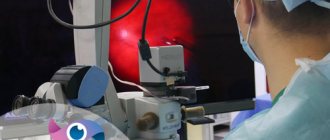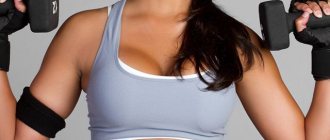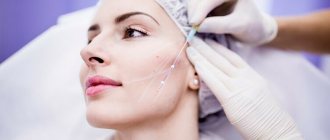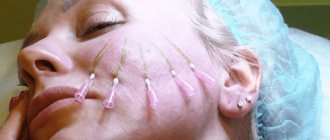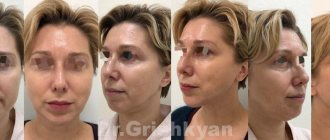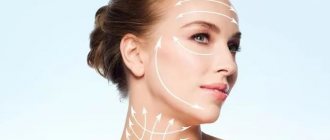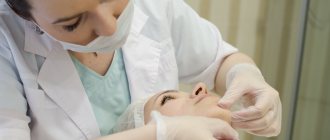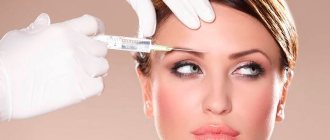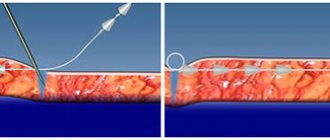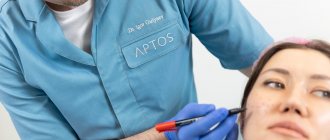Most studies on the use of resorbable threads for skin tightening are devoted to indications for their use, installation techniques and clinical results. But how the threads behave during implantation is a little-studied question. How soon and how do threads biodegrade? How do tissues respond to their implantation? Does the nature of tissue reactions depend on the material of the threads, their structure, and quantity?
Each society has its own idea of beauty and its own hierarchy of values. At the same time, the key task for all societies is the same - the continuation of the human race, and in its solution in any society one of the main roles is assigned to external attractiveness. Being liked by representatives of the opposite sex means finding a partner in time, starting a family, having children, and getting more positive emotions from communicating with people. All this makes even not very young people happier. After all, a person retains the ability to love, including himself, until a very old age, so the problem of appearance remains extremely relevant throughout life.
With age, the skin, including subcutaneous fat tissue (SFA), undergoes significant biochemical and structural-morphological restructuring: its turgor and elasticity decrease, and processes of fibrosis and atrophy partially develop. As a result, the tissues become flabby and sag under the influence of gravity. These involutional changes are characteristic of both the skin of the face and body.
Aesthetic medicine has various methods of combating the manifestations of age-related changes, both surgical and cosmetological (therapeutic). Thread technologies are becoming increasingly popular, and the threads used are very diverse.
Resorbable and non-resorbable threads
Conventionally, threads can be divided into three groups:
- non-absorbable, for example, gold (platinum) threads, Gore-Tex (made of polytetrafluoroethylene), Spring Thread (made of polyester fiber placed in a special silicone shell);
- absorbable, such as Silhouette Lift Soft (from polylactic and glycolic acids), Lead Fine Lift (from polydioxanone - PDO), Resorblift (from 100% high molecular weight polylactic acid - PLA);
- combined threads - these currently only include Silhouette Lift threads (polypropylene threads with polylactic acid cones).
When studying the interaction of tissues with non-absorbable threads, it was found that a characteristic reaction to their implantation is acute and productive inflammation in the tissue around the ligature channels. This mainly occurs as a result of destruction of tissue cells by the needle and the thread itself with an uneven surface. The severity of such inflammation depends on the structure, thickness and physical characteristics of the thread used. It has been noticed that the thicker the thread, the more tissue is injured and the larger the area of inflammation. Also, the thread itself can serve as a conductor for bacterial flora. Over time, while the inflammatory reaction of the tissue persists, fibrous-degenerative changes develop (K.V. Lapkin, 1998); such threads can cause a strong inflammatory reaction (Michael S. Godin et al., 1999).
An alternative to non-resorbable threads has become threads made from absorbable materials. It must be emphasized that today the requirements for them, primarily for the level of their atraumaticity, biodegradation and biocompatibility, have become significantly more stringent. As for their “behavior” in tissues, many questions remain unclear. Most studies on resorbable sutures focus on the indications for their use, installation technique, and clinical results. Such works do not reflect the mechanisms of action of threads, do not provide reliable data on the properties of threads, the effectiveness and safety of their use, or the longevity of the results of thread correction of skin changes. Therefore, an important task is to study tissue reactions to the implantation of resorbable threads, assess the degree of their biodegradation, as well as the dependence of the tissue reaction on the number of implanted threads.
In a study conducted at the city clinical hospital named after. S. P. Botkin and the research laboratory of the Russian Medical Academy of Postgraduate Education (Moscow), the features of interaction with biological tissue of various absorbable threads were studied.
Efficiency of application
The use of the Resorblift product is aimed at non-surgical solutions to age-related and other defects in various parts of the body. The material is used for skin tightening:
- faces (under the eyes, eyebrows, cheeks, cheekbones, nasolabial folds, oval contours);
- neck, décolleté, chest;
- body (stomach, arms, thighs).
The effectiveness of Resorblift threads is noticeable when:
- severe ptosis;
- wrinkles of different depths;
- decreased skin turgor (thinning, sagging);
- puffiness of the face.
Attention! The use of Resorblift threads is indicated for the correction of obvious changes. The material is usually used when working with patients 30–50 years old. Threads do not cause allergic reactions. The material can be used to work with thin, flabby, sensitive skin.
The results of thread lifting based on the Resorblift product are equated to the achievements of classical surgical plastic surgery. Patients observe successful contour tightening, elimination of defects, and subsequent improvement in skin condition. The retention of the effect is prolonged, usually the results last up to 3-5 years.
Materials, methods, research objectives
Using a random sampling method, 5 groups of animals (16 in each) were formed from 80 animals (non-inbred male rats), in which different resorbable materials were used:
- Group I – smooth monofilament thread Lead Fine Lift (South Korea), composition – PDO;
- Group II – monofilament thread Resorblift (France) with notches, composition – PLA 100%;
- Group III – Silhouette Lift Soft monofilament thread (USA) with cones, composition – polylactoglycolide (PLA + glycolic acid in a ratio of 4:1);
- Group IV – high-density hyaluronic acid preparation Amaline – λ. 200;
- Group V, control – smooth polyfilament thread Vicryl (USA), which is a traditional suture surgical material with well-studied properties, composition – 90% glycolide and 10% L-lactide.
On the 14th, 30th, 90th and 180th days after the installation of threads in animals, we performed a histological analysis of tissues with implanted threads. A total of 220 samples were studied.
The tasks of the work included:
- pathomorphological study of the characteristics of tissue reactions after implantation of absorbable threads from various materials;
- in an animal experiment, study the timing and degree of biodegradation of absorbable threads, evaluate the significance of the composition of the threads, the influence of the physical properties of the threads on soft tissues;
- determine the dependence of tissue reactions on the number of implanted threads, the boundaries of local tissue changes and the influence of threads on angiogenesis and collagenogenesis.
In this article we will look at what happens in tissues after implantation of resorbable threads using the example of the “behavior” of Resorblift threads according to the results shown in our study (experiment in group II of animals).
Cost of the procedure
The price of the operation is determined individually. At the preliminary consultation, the cosmetologist names the estimated cost.
The total amount depends on the number of threads needed to solve the problems. The price tag is supplemented by payment for the cosmetologist’s work. The cost of 1 Resorblift thread 26 cm long with installation ranges from 20–25 thousand rubles.
The procedure is carried out in beauty salons. Due to the high cost of the operation, the use of the product is not widespread.
Composition and design of Resorblift threads
Resorblift thread consists of 100% high molecular weight PLA - the most popular biopolymer, which is made from dextrose (sugar) extracted from biomaterials. All grades of this material have a certificate confirming their ability to biochemically degrade in accordance with the requirements of the international standard EN12342. The use of biodegradable polymers in medicine is given in Table 1
.
These materials remain in the tissues temporarily and are completely eliminated from the body as they biodegrade.
Lactic acid is a natural product of the body, associated with the muscle structure of animals and humans. Acid is produced metabolically in the body during physical activity. In the body, lactic acid is converted into pyruvic acid, with the transition to tricarboxylic acids and decomposition to carbon dioxide and water. Significant accumulation of decomposition products was not found in any organ, which indicates the ability of the material to undergo complete resorption and proves the safety and feasibility of using PLA-based threads as implants.
Table 1. Medical applications of bioresorbable PLA polymers
| Purpose | Functions | Examples |
| Operations | Bonding, closing, separating | Vascular anastomoses, bone fixation, hemostasis |
| Injuries | Healing | Wound healing, tissue growth, organ reconstruction |
| Indications of different etiologies | Implants, drugs, threads | In antitumor therapy to accelerate healing, angiogenesis, collagenogenesis, as an anti-infective agent |
The Resorblift thread has micro-notches with protrusions along the entire length, which are directed in opposite directions from the middle of the thread. The thread is inserted using a guide needle in the direction from the periphery to the center, with a rotating oblique vector of soft tissue tension.
Experimental results: resorption of threads and tissue reactions to their implantation
After implantation of Resorblift threads, the following processes were observed:
14th day
– in the subcutaneous fatty tissue (SFA), the formation of a very thin layered connective tissue capsule around the thread was noted. The capsule consists of thin circular collagen fibers and fibroblasts, and is lined in places with one or more layers of macrophages and giant multinucleated cells. In the adipose tissue around the thread, moderate infiltration of macrophages with an admixture of lymphocytes and single neutrophils is detected. Near the capsule, the total number of vascular elements with good blood supply increased.
30th day
– in the PFA, a capsule of 7–9 layers of circularly arranged collagen fibers and fibroblasts is visible. On its inner surface there are relatively few macrophages and single giant cells. The number of these cellular elements is less compared to those noted on the 14th day, and the capsule tissue is more mature.
90–180 days
– the thickness of the capsule in the pancreas at the border with muscle tissue increased compared to that noted on the 30th day of the study. The capsule consists of dense fibrous-scar tissue, sometimes hyalinized. The collagen fibers of the capsule tissue are tightly adjacent to each other, the boundaries between them are not visible, the cells are represented by spindle-shaped elongated fibroblasts. On the inner and outer sides, the capsule is lined with a single layer of fibroblasts and a few macrophages. There are no giant cells. When the position of the microscope condenser changes inside the capsule, the structure of the thread is visible, consisting of very thin transparent “shards” that are not stained with dyes.
The observations confirmed that the most important influence on the interaction of threads with tissues is the composition of the thread material and design features, on which the physical properties of the implant depend. Thus, threads from PLA began to be resorbed on the 90th day after implantation, in contrast to mono- and polyfilament threads of other compositions (for example, PDO biodegradation was noted on the 60th day, resorption of a smooth polyfilament thread from glycolide and L-lactide was already on 30th day).
The study found that the formation of fibrous tissue around the Resorblift threads, which supports the soft tissues in the initial rotational oblique vector of tension, begins on the 120th day after their implantation. Further observations showed that complete resorption of the threads, followed by local changes in soft tissue (formation of fibrous fibers outside the capsule) occurs 10–12 months after implantation. As a result, the fibrous tissue at the location of the threads gradually resolves (the duration of this period varies from person to person). The data obtained suggest that the duration of the effect for Resorblift threads can be 2.5–3 years from the moment of their implantation.
The physical properties of the threads also affect the period of hydrolysis, the period of thread fragmentation, the formation of fibrous tissue, angiogenesis, and collagenogenesis. In the study, barbed sutures produced wider capsules and greater local tissue changes than smooth sutures, but both to a lesser extent than tapered sutures.
As an example, we give Table 2
, which shows a direct relationship between the increase in the volume of the thread (due to hydrolysis), the width of the capsule formed around the thread and local tissue changes associated with the formation of the capsule. These data show that the larger the diameter of the thread, the greater the width of the capsule and the more pronounced local tissue reactions.
Table 2. Dependence of changes in thread volume, capsule width and local tissue changes during thread hydrolysis
| Smooth thread | Resorblift barbed threads | Threads with cones | |
| Thread size, mm | d ±0.250 | d ±0.350 + notch 0.15 | d ±0.50 + cone 3.0 |
| Hydrolysis of the thread with disintegration (increase in thread volume, in mm) | ±0,50 | ±1,0–1,3 | ±4,0–4,5 |
| Increase in capsule size (width), mm | ±1,0 | ± 3,0–3,5 | ± 6,0–7,0 |
| Local tissue reaction associated with capsule formation (increase in fibrous cords, mm) | ±2,0 | ± 7,0–7,5 | ± 9,5–10,0 |
It is important to emphasize: each type of thread provides its own method of application, which significantly expands the doctor’s choice and the possibility of individualizing the approach to thread correction performed for a particular patient. Thus, implantation of threads with notches provides for upward rotation of soft tissues (against the vector of gravitational ptosis), without fixation of threads to fixed structures, more reliable support of tissues in a new position due to notches. Smooth threads are located freely in the tissues; installation of threads with cones involves corrugation of soft tissues.
conclusions
Biodegradation of Resorblift threads begins from the 90th day after their implantation, occurs through hydrolysis, which causes an increase in the volume of the threads (due to the attraction of liquid).
The resorption period of Resorblift can be 90–120 days from the beginning of fragmentation.
Resorblift threads give a weak tissue reaction, which indicates their bioinertness.
Local tissue reactions to threads are determined by the width of the capsule, as well as the maximum distance from the thread at which pathomorphological changes were noted.
The complication of the structure of the threads with notches due to constant irritation of surrounding tissues significantly increases the new formation of microvessels, which has a positive effect on angiogenesis and collagenogenesis (production of collagen types I, II, IV).
The study confirmed the formation of fibrous capsules around the introduced Resorblift threads, which provides a clinical effect when implanted into the soft tissues of the face and body.
The results of the study indicate the effectiveness of the use of resorbable threads Resorblift for the correction and prevention of involutional changes in the face and body.
Contraindications
The patient must come to the operation in good health. Ailments in the form of headaches, mild respiratory diseases, increased temperature, and blood pressure are reasons to reschedule the date of the procedure. The intervention is completely abandoned if:
- autoimmune, oncological diseases;
- acute course of infectious, somatic, chronic disorders;
- systemic blood diseases, tendency to scar formation;
- serious endocrine, cardiovascular, mental deficiencies.
It is recommended to avoid surgery during pregnancy and lactation.
Recommendations for insertion depth of Resorblift threads
- The thickness of the capsules and the degree of fibrosis of the tissue around them, as well as the compaction of the dermis of the skin near the threads, largely depend not only on the type of threads, but also on the site of implantation: the closer to the dermis, the more pronounced the fibrosis. Based on the identified facts, we recommend introducing Resorblift threads into the deep layers of the dermis and subcutaneous fat, otherwise the following complications and undesirable results may occur:
- when introducing a thread into the upper layers of the dermis - contouring, age spots, inflammatory infiltrates, fibrous conglomerates, protrusion of the ends of the threads after implantation;
- when introducing threads into the subcutaneous fat deeper than 8 mm, there is no effect from the implantation.
- Resorblift threads are used to strengthen the connective tissue framework of the dermis. They are installed in a certain sequence at a distance of 1.5 cm from each other according to the recommended scheme for introducing threads for each zone.
In conclusion, we emphasize that the results of the study confirmed the effectiveness, safety and prospects of techniques based on the use of resorbable threads. They simultaneously provide two effects: pronounced skin tightening and improvement of its quality characteristics.
However, these techniques are relatively new, so the question of the need for evidence-based research in this area remains relevant.
Threads from PLA began to be resorbed on the 90th day after implantation, in contrast to mono- and polyfilament threads of other compositions (for example, biodegradation of PDO was noted on the 60th day, resorption of a smooth polyfilament thread from glycolide and L-lactide - already on the 30th day). e day).
The physical properties of the threads affect the period of hydrolysis, the period of fragmentation of the thread, the formation of fibrous tissue, angiogenesis, collagenogenesis. In the study, barbed sutures produced wider capsules and greater local tissue changes than smooth sutures, but both to a lesser extent than tapered sutures.
